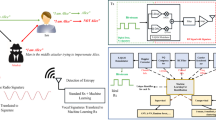Abstract
Hidden node is a fundamental problem that severely degrades the performance of wireless networks. The problem occurs when nodes that do not hear each other transmit at the same time, which leads to data packet collision. IEEE 802.11 Wireless Local Area Networks (WLANs) tries to solve this problem through the Request to Send/Clear to Send (RTS/CTS) mechanism. However, the mechanism is not wholly successful. The RTS/CTS idea is based on the assumption that all nodes in the vicinity of Access Points will hear CTS packets and consequently defer their transmissions. The shortcoming of RTS/CTS stems from the fact that such packets introduce high overhead if extensively used. In this article, we propose a hybrid approach for detecting hidden nodes in 802.11 WLANs. The approach is mainly based on adaptive learning about collisions in the network. We think that the approach will be useful for controlling the tuning of RTS/CTS threshold and therefore reduce the overhead those packets introduce. Detailed simulation experiments have shown the strength of the proposed approach compared with other approaches.





Similar content being viewed by others
References
Abusubaih M, Rathke B, Wolisz A (2008) Collaborative setting of RTS/CTS in multi-rate multi-BSS IEEE 802.11 Wireless LANs, IEEE LANMAN
Abusubaih M (2009) Cognitive wireless local area networks. Ph.D. thesis, Technical University Berlin
Kim Y, Yu J, Choi S, Jang K (2006) A novel hidden station detection mechanism in IEEE 802.11 WLAN. IEEE Communications Letters
Li FY, Kristensen A, Engelstad P (2006) Hidden terminal detection in 802.11-based wireless ad hoc networks. In: Proceedings of the IST summit
S. Khurana, A. Kahol, A.P. Jayasumana (1998) Effect of Hidden Terminals on the Performance of IEEE 802.11 MAC Protocol, In: Proceedings of 23rd Annual Conference on Local Computer Networks LCN 98
Sheu S-T, Chen T, Chen J, Ye F (2002) The impact of RTS threshold on IEEE 802.11 MAC protocol. In: Proceedings of the ninth international conference on parallel and distributed systems
Hou T-C, Tsao L-F, Liu H-C (2003) Analyzing the throughput of IEEE 802.11 DCF scheme with hidden nodes. In: Proceedings of the IEEE 58th Vehicular Technology Conference VTC 2003-Fall
Choi W-Y, Lee S-K (2004) A real-time updating algorithm of RTS-CTS threshold to enhance EDCA MAC performance in IEEE 802.11e wireless LANs. In: Proceedings of the IEEE 60th Vehicular Technology Conference VTC 2004-Fall
Zhang L, Shu Y (2005) RTS threshold self-tuning algorithm based on delay analysis on 802.11 DCF. In: Proceedings of the international conference on wireless communications networking and mobile computing
Liu J, Guo W, Xiao B, Huang F (2006) RTS threshold adjustment algorithm for IEEE 802.11 DCF. In: Proceedings of the 6th international conference on ITS telecommunications
Sobrinho JL, de Haan R, Brazio JM (2005) Why RTS-CTS is not your ideal wireless LAN multiple access protocol. In: Proceedings of the 6th international conference on ITS telecommunications
Rahman A, Gburzynski P (2006) Hidden problems with the hidden node problem. In: Proceedings of the 23rd Biennial symposium on communications
Hung F-Y, Pai S, Marsic I (2006) Performance modeling and analysis of the IEEE 802.11 distribution coordination function in presence of hidden stations. In: IEEE Military Communications Conference
Hung F-Y, Marsic I (2007) Analysis of non-saturation and saturation performance of IEEE 802.11 DCF in the presence of hidden stations. In: IEEE Vehicular Technology Conference
Tsertou A, Laurenson DI (2008) Revisiting the hidden terminal problem in a CSMA/CA Wireless Network. In: IEEE Transactions on Mobile Computing
Koscielnik D (2008) Simulation study of the influence of hidden stations for the quality of service in the IEEE802.11e WLAN. In: IEEE International Symposium on Industrial Electronics
Ekici O, Yongacoglu A (2008) Modeling hidden terminals in IEEE 802.11 networks. In: IEEE 19th international symposium on Personal Indoor and Mobile Radio Communications, PIMRC
Lee J (2009) Student Member, Ikjun Yeom, Avoiding collision with hidden nodes in IEEE 802.11 wireless networks. IEEE Communications Letters
Liu F, Lin J, Tao Z, Korakis T, Erkip E, Panwar S (2010) The hidden cost of hidden terminals. IEEE ICC
Abusubaih M, Rathke B, Wolisz A (2009) A framework for interference mitigation in multi-BSS 802.11 Wireless LANs. IEEE WoWMoM
NCTUns v2.0 Simulator (2006) Available at: http://nsl.csie.nctu.edu.tw/nctuns.html
Acknowledgements
I would like to thank my Ph.D. supervisor Prof.–Dr.Ing Adam Wolisz (Technical University Berlin) for providing very useful inputs during the initial phase of this work. I am also grateful to Mr. Berthold Rathke from TU-Berlin for the time he spent in technical discussions of the basic idea and the important questions he used to raise.
Author information
Authors and Affiliations
Corresponding author
Rights and permissions
About this article
Cite this article
Abusubaih, M. A combined approach for detecting hidden nodes in 802.11 wireless LANs. Ann. Telecommun. 66, 635–642 (2011). https://doi.org/10.1007/s12243-011-0239-x
Received:
Accepted:
Published:
Issue Date:
DOI: https://doi.org/10.1007/s12243-011-0239-x




